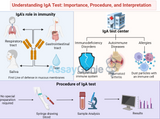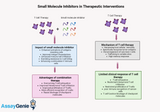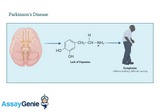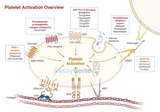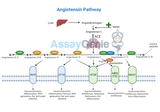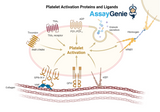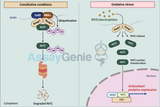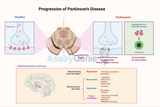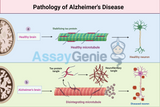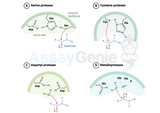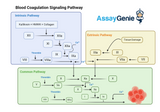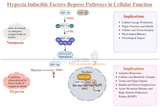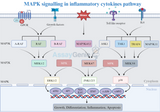Blog
Illuminating the Multifaceted Role of Acetylation: Bridging Chemistry and Biology Introduction:
Acetylation, a chemical process characterized by the addition of an acetyl functional group to a molecule, stands as a cornerstone in both biochemical and biological landscapes. Its significance traverses diverse realms, ranging from fundamental cellular processes to intricate disease pathogenesis. This article endeavors to delve deeper into the multifaceted world of acetylation, exploring its intricate mechanisms, diverse functions, and far-reaching implications in health and disease. Chemistry of Acetylation: Acetylation, at its essence, involves the transfer of an acetyl group (-COCH3) to a substrate molecule, a process catalyzed by enzymes known as acetyltransferases. T
…
16th Apr 2024
Understanding IgA Test: Importance, Procedure, and Interpretation
The IgA test, also known as immunoglobulin A test, is a diagnostic tool used to measure the levels of IgA antibodies in the blood. Immunoglobulin A (IgA) is a type of antibody that plays a crucial role in the immune system's defense against infections. This test helps in diagnosing certain medical conditions related to the immune system, such as autoimmune diseases and allergies. In this comprehensive guide, we will delve deeper into the importance of the IgA test, its procedure, interpretation of results, factors affecting IgA levels, and clinical significance. Importance of IgA Test: Immunoglobulin A is primarily found in mucous membranes, particularly those lining the re
…
15th Apr 2024
Biomarker Testing: Advancements, Applications, and Future Directions
Biomarkers, measurable indicators of biological processes or responses to therapeutic interventions, play a pivotal role in modern healthcare. They provide clinicians with valuable information for disease detection, prognosis assessment, and treatment optimization. Biomarker testing encompasses a wide array of techniques and platforms, ranging from simple immunoassays to sophisticated genomic analyses. Over the past few decades, significant advancements in biomarker research have revolutionized clinical practice, leading to more personalized and precise approaches to patient care. Types of Biomarkers: Biomarkers encompass a diverse array of molecular entities that reflect v
…
14th Apr 2024
The Rat Effectively Models Signature Cytokines of T Helper Cells
Understanding the immune system's intricacies requires models that accurately reflect its complexity. The rat, as a model organism, plays a crucial role in immunological research, particularly in the study of T helper (Th) cells and their signature cytokines. This article explores how rats model the signature cytokines of Th cells, shedding light on their contributions to immunological research. Introduction to T Helper Cells and Their Cytokines T helper cells, a subset of T cells, are pivotal in the immune system's adaptive response. They assist other cells in the immune system through the secretion of cytokines, signaling molecules that modulate the immune response. These cell
…
26th Mar 2024
Advantages of Small Molecule Inhibitors in Therapeutic Interventions
Small molecule inhibitors represent a significant advancement in the field of therapeutic interventions, offering a versatile approach to treating a myriad of diseases, including cancer, viral infections, and chronic inflammatory conditions. These compounds, typically with a molecular weight of less than 900 daltons, can modulate biological processes by interacting with specific protein targets within the cell. This article explores the multifaceted advantages of small molecule inhibitors, highlighting their role in the development of targeted therapies. Target Specificity and Selectivity: One of the paramount advantages of small molecule inhibitors is their ability to selectivel
…
13th Mar 2024
Understanding Blotchy Western Blots: Causes and Remedies
Western blotting is a powerful and widely used technique in molecular biology, essential for detecting and quantifying specific proteins in complex biological samples. However, despite its popularity, Western blotting can sometimes yield frustrating results, with one of the most common issues being blotchy or uneven bands. Blotchy Western blots can arise from various factors, ranging from sample preparation to technical errors during the blotting process. In this article, we'll delve into the potential causes of blotchy Western blots and provide some tips to rectify them. What are Blotchy Western Blots? Blotchy Western blots refer to the uneven distribution of bands across
…
13th Mar 2024
Decoding Parkinson's Disease: Insights into a Complex Neurological Disorder
Parkinson's disease (PD) is a progressive neurological disorder that primarily affects the motor system, leading to a wide array of symptoms ranging from tremors and stiffness to bradykinesia (slowness of movement) and postural instability. Beyond these hallmark motor symptoms, Parkinson's disease can manifest in non-motor symptoms such as cognitive decline, mood disorders, and autonomic dysfunction, making it a multifaceted condition that challenges both individuals and healthcare systems worldwide. This article delves into the etiology, pathophysiology, clinical manifestations, and therapeutic strategies for Parkinson's disease, shedding light on the complexities of this debilitating d
…
16th Feb 2024
Understanding Platelet Activation: A Comprehensive Overview
Platelet activation plays a pivotal role in hemostasis, the process that stops bleeding and initiates tissue repair after vascular injury. This complex biological mechanism involves the transformation of platelets from a resting state to an active state, enabling them to adhere to the site of injury, aggregate with other platelets, and interact with the coagulation cascade to form a stable blood clot. This article delves into the mechanisms of platelet activation, its significance in hemostasis, and the implications for pathological conditions when dysregulated. The Mechanisms of Platelet Activation Platelet activation is initiated by several triggers, including vascular injury,
…
14th Feb 2024
Angiotensin Pathways: Unlocking the Secrets to Blood Pressure Regulation and Beyond
The angiotensin pathway is a pivotal hormonal system that plays a crucial role in regulating blood pressure and maintaining fluid and electrolyte balance within the body. This complex biochemical cascade not only underpins essential physiological processes but also serves as a target for therapeutic interventions in conditions such as hypertension, heart failure, and chronic kidney disease. Understanding the Renin-Angiotensin System (RAS): At the heart of the angiotensin pathway lies the renin-angiotensin system (RAS), a regulatory circuit that influences systemic vascular resistance and, consequently, arterial blood pressure. The RAS pathway initiates with the synthesis of angio
…
14th Feb 2024
Platelet Adhesion Proteins and Ligands: Key Players in Hemostasis and Thrombosis
Platelet adhesion is a critical process in the maintenance of hemostasis, the body's response to bleeding. This intricate process involves a series of interactions between platelets, the cellular components of blood, and the vascular endothelium, the inner lining of blood vessels. At the core of this process are specific proteins and ligands that mediate the initial steps of platelet adhesion, activation, and aggregation, ultimately leading to the formation of a platelet plug that aids in the cessation of bleeding. This article delves into the vital roles of platelet adhesion proteins and their ligands, shedding light on their significance in both physiological and pathological contexts.
…
13th Feb 2024
NRF2 Signaling: A Keystone in Inflammation and Disease Management
Nuclear Factor Erythroid 2–Related Factor 2 (NRF2) orchestrates a principal defense mechanism against oxidative stress and plays a pivotal role in inflammation and disease pathogenesis. This article explores the mechanism of NRF2 signaling, its intricate relationship with inflammation, its implications in various diseases, and the therapeutic potential of NRF2 modulation. Understanding NRF2 Signaling Basic Mechanism of Action NRF2 is a transcription factor that, upon activation, migrates to the nucleus to bind to Antioxidant Response Elements (ARE) in the DNA, promoting the expression of genes involved in antioxidant defense, detoxification, and cellular homeostasis.
…
12th Feb 2024
The Battle of Antibiotics: Penicillin vs. Streptomycin
In the realm of medicine, antibiotics are akin to superheroes, combating bacterial infections with unwavering efficacy. Among these, two stalwarts stand out: penicillin and streptomycin. These antibiotics revolutionized the treatment of bacterial infections, saving countless lives since their discovery. However, understanding their differences and applications is crucial for effective medical management. Let's delve into the fascinating world of penicillin versus streptomycin and explore the unique properties of Penicillin-Streptomycin Solution. Penicillin: The Pioneer Discovered accidentally by Alexander Fleming in 1928, penicillin marked the dawn of the antibiotic era. Fl
…
8th Feb 2024
What is the difference between PBS and dPBS?
In the realm of biological and biochemical research, solutions play a pivotal role in various experimental procedures, from cell culture to molecular biology assays. Among the plethora of solutions utilized, phosphate-buffered saline (PBS) and Dulbecco’s phosphate-buffered saline (DPBS) stand out as crucial components. While both solutions share similarities, they possess distinct compositions and applications that merit exploration and understanding. Phosphate-Buffered Saline (PBS): A Versatile Solution PBS, a staple in laboratories worldwide, serves as a fundamental isotonic buffer solution utilized across diverse applications. Its composition typically consists of
…
8th Feb 2024
Transduction vs Transfection: Understanding Gene Delivery Techniques
In the realm of molecular biology and genetic engineering, the ability to deliver genetic material into cells is fundamental for various research and therapeutic purposes. Two common methods employed for this purpose are transduction and transfection. While both techniques facilitate the introduction of exogenous genetic material into cells, they differ significantly in their mechanisms and applications. This article aims to elucidate the distinctions between transduction and transfection, highlighting their respective advantages, limitations, and applications. Transduction: Transduction is a process by which genetic material is transferred into a cell via a viral vector.
…
8th Feb 2024
Understanding Parkinson's Disease: Insights and Innovations
Parkinson's disease (PD) is a progressive neurological disorder that predominantly affects the motor system, leading to a wide range of symptoms including tremors, rigidity, bradykinesia (slowness of movement), and postural instability. This article delves into the pathophysiology, symptoms, diagnosis, and treatment options for Parkinson's disease, providing a comprehensive understanding of this complex condition. Understanding Parkinson's Disease Pathophysiology Parkinson's disease is characterized by the degeneration of dopamine-producing neurons in the substantia nigra, a region of the brain that plays a critical role in regulating movement. The decline in dopamine leve
…
8th Feb 2024
Alzheimer's Disease: A Comprehensive Insight
Alzheimer's disease stands as a formidable challenge in the realm of neurological disorders, characterized by its progressive nature and profound impact on cognitive functions. This article delves deeper into the facets of Alzheimer's disease, exploring its causes, mechanisms, clinical manifestations, and current therapeutic strategies, enriched with current scientific insights. Etiology and Risk Factors Genetic Factors The genetic landscape of Alzheimer's disease is complex, with both hereditary (familial AD) and sporadic forms. Key genes implicated in its pathogenesis include the amyloid precursor protein (APP), presenilin-1 (PSEN1), and presenilin-2 (PSEN2). Mutations i
…
7th Feb 2024
Protease vs Peptidase: Understanding Enzymatic Digestion
In the complex world of biochemical processes, enzymes play a crucial role in catalyzing various reactions necessary for life. Among these enzymes, proteases and peptidases are fundamental players involved in the breakdown of proteins and peptides, respectively. While their names might sound similar and their functions somewhat overlap, they serve distinct purposes in the realm of enzymatic digestion. Let's delve deeper into their definitions, functions, and types to gain a comprehensive understanding. Protease: The Protein Digesters Proteases, also known as proteolytic enzymes or proteinases, are enzymes that catalyze the hydrolysis of peptide bonds within proteins. These
…
6th Feb 2024
Blood Coagulation Signaling Pathways: A Critical Overview
Blood coagulation is a fundamental physiological process that prevents excessive bleeding when the vascular system is injured. It involves a complex cascade of events that lead to the formation of a stable fibrin clot. This process is tightly regulated by various signaling pathways to ensure that coagulation occurs promptly and appropriately in response to vascular injury, without leading to thrombosis or bleeding disorders. This article delves into the critical signaling pathways involved in blood coagulation, highlighting their roles, mechanisms, and the potential for therapeutic intervention. The Coagulation Cascade: An Overview The coagulation cascade is traditionally divided
…
5th Feb 2024
p38 MAPK Signaling Review
The p38 MAPK signaling pathway is an intracellular signaling pathway that plays a crucial role in cellular responses to various stressors and inflammatory stimuli. It is a part of the larger MAPK superfamily, which also includes ERK and JNK pathways. The p38 MAPK pathway is involved in regulating a wide range of cellular processes, including cell proliferation, differentiation, apoptosis, inflammation, and immune responses. Key Takeaways: p38 MAPK, part of the MAPK family, is key in cellular responses to stress and inflammation. This pathway regulates cell processes like proliferation, differentiation, apoptosis, and immune responses. The MAPK family includes ERKs, JNKs, and p38
…
1st Feb 2024
Serum vs. Plasma: A Deep Dive into Their Molecular Makeup and Implications for ELISA
Blood plasma and serum are essential components of blood and have distinct molecular compositions and uses in the medical and research fields. This article aims to elucidate the differences between serum and plasma and respond to the most frequently asked questions. Key Takeaways: Serum is blood fluid without clotting factors; plasma contains these factors. They're crucial in medical research, including ELISA, to measure various analytes. Different collection methods are used for serum and plasma. What is Serum vs Plasma? Blood consists of red and white cells, platelets, and a liquid portion, known as plasma. When blood is collected and coagulates, the solid components,
…
24th Jan 2024
Articular Cartilage Extracellular Matrix
Articular cartilage, a key player in joint function, owes its unique properties to its extracellular matrix (ECM). This complex, highly specialized structure is not only fundamental in maintaining joint integrity but also in ensuring smooth and efficient movement. The ECM of articular cartilage is a masterful creation of nature, intricately designed to withstand compressive forces while providing a lubricated surface for articulation. Understanding the Composition of ECM in Articular Cartilage Proteoglycans: The Hydration Masters: The ECM of articular cartilage is rich in proteoglycans, primarily aggrecan. These macromolecules play a crucial role in retaining water, giving
…
23rd Jan 2024
HIF Repress Pathways: An Insight into Cellular Oxygen Homeostasis
Hypoxia-inducible factors (HIFs) are pivotal in the cellular response to oxygen deprivation. These transcription factors regulate various aspects of cellular and systemic homeostasis in response to hypoxia. Central to their role is the activation of genes that aid in adaptation to low oxygen conditions. However, equally important, yet less emphasized, is their ability to repress certain pathways. This article delves into the mechanisms and implications of HIF-mediated repression pathways in cells. Mechanisms of HIF-Mediated Repression Transcriptional Repression Through HIF: HIFs function primarily as transcriptional activators. However, they can indirectly repress gene expr
…
22nd Jan 2024
MAPK Signaling in Inflammatory Cytokines Pathways
The Mitogen-Activated Protein Kinase (MAPK) pathway is a pivotal signaling cascade that plays a crucial role in mediating cellular responses to various external stimuli. This pathway is intricately involved in the regulation of inflammatory cytokines, key signaling molecules in the immune system. Understanding the MAPK signaling pathway in the context of inflammatory cytokines is essential for grasping the molecular basis of inflammation and its related disorders. Overview of MAPK Signaling Fundamental Components and Activation: MAPK signaling encompasses a series of protein kinases that transmit signals from the cell surface to the nucleus. These kinases include the Extrac
…
22nd Jan 2024
JAK-STAT Signaling Pathway: A Comprehensive Exploration
window.SHOGUN_IMAGE_V2_ELEMENTS = window.SHOGUN_IMAGE_V2_ELEMENTS || new Array();
window.SHOGUN_IMAGE_V2_ELEMENTS.push({ uuid: 's-45124fd5-9a75-444d-b680-b8339e2a814d' })
Progression of the JAK STAT Signalling Pathway Cellular communication is a complex network of molecular interactions that govern various physiological processes. Among the many signaling pathways, the Janus kinase-signal transducer and activator of transcription (JAK-STAT) pathway plays a pivotal role in mediating signals from the cell surface to the nucleus. This pathway is essential for regulating immune responses, cell proliferation, differentiation, and survival. In this article, we will delv
…
18th Jan 2024


